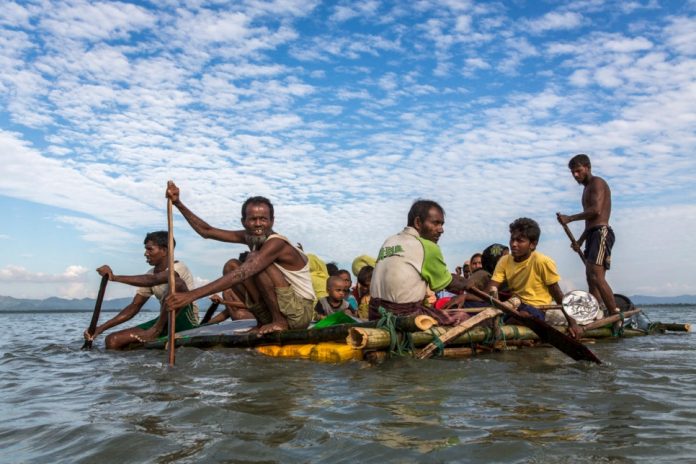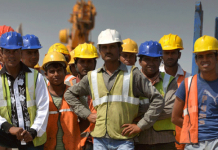This article is written by Darshit Vora of Narsee Institute of management Studies this article analyses various schemes providing benefits for migrant workers. Further, the article mentions the present condition of the migrant workers during the time of pandemic and various problems faced by them in this period.
Table of Contents
Introduction
After globalization, there was a sudden shift of population from rural areas to the urban areas. The people moved to urban areas with a thought of living a luxurious life but in the end got engaged in the informal sector where there are no social security measures provided to the workers, non-establishment of trade unions, less wage rate, etc. Even after various disadvantages, in 2016-17 it employed 81% of people in India. The informal sector has a significant contribution to the Indian GDP.
The International organization of migration has defined migrants as a person who moves away from his or her place of residence, whether within a country or across an international border, temporarily or permanently, and for a variety of reasons. International labour organization grants various rights to the migrant workers like freedom of speech, safety against any sexual abuse, equal treatment of workers, etc.
Few reasons for migration
|
Push Factor |
Pull Factor |
|
Lack of wages |
Better quality of life |
|
Few job opportunities |
Safety and stability |
|
Violence |
More availability of jobs. |
Safety factor
People migrate from their domestic household due to safety reasons. Some of the reasons are persecution, discrimination based on race, religion, political belief, etc.
Economic factor
People migrate from their residential areas to improve their economic condition. Higher wages, better job prospects, etc. these are some reasons for the economic shift.
Environmental factor
People migrate from their place of accommodation to escape from various environmental hazards. Pollution, tsunamis, hurricanes are some reasons why people migrate.
Social facts
People migrate to improve their standard of living which is not available to them, where they previously resided in. Better school facilities, proper food availability, a better environment, etc are some examples which lead to the migration of people.
Schemes to provide aid to migrant workers
According to Article 38 of the Indian Constitution, the state must promote the welfare of the people and provide opportunities and reduce economic inequalities. Complying with this directive principle, states have passed various schemes to improve the status of livelihood of migrant workers and improve their standard of living.
Various schemes are as follows:
Indira Gandhi National Old Age Pension Scheme
The national old-age pension scheme was renamed as Indira Gandhi national old-age pension scheme and it was launched in the year 2007.
Requirements of the scheme
Eligibility criteria:
- The age of the applicant should be either 60 years or more than that.
- The applicant doesn’t have a regular source of income to support his/ her own family.
- The applicant is below the poverty line.
Amount
The people between the ages of 60 to 79 living below poverty will get 200 rupees per month. People above the age of 80 living below the poverty line will get 500 rupees every month.
Features of this scheme:
- It is a non-contributory scheme.
- Senior people are given monthly pensions.
- Pension payment is directly transferred to the applicant’s bank account or post office account.
- Families in which more than one person is having the age between 60-79 or above 80 each of then would receive the pension.
Documents required:
- Passport size photographs.
- Income certificate.
- Below poverty line card.
- Bank passbook or post passbook.
- Copy of proof of age attested by the medical officer.
- Application form of Indira Gandhi national old-age pension scheme.
This pension scheme benefits those migrant workers who are living below the poverty line to satisfy their basic needs after reaching a particular age.
Janani Suraksha Yojana
It is a scheme in which cash assistance is provided to poor pregnant women at the time of delivery or post-delivery to reduce the mortality rate. This Janani Suraksha Yojana was in the year 2005.
Requirements of the scheme
Eligibility criteria:
- Above the age of 18.
- A woman should be pregnant.
- High Performing States: Women should belong from SC, ST, or BPL and the delivery should happen in the government centers, state, or district hospitals.
- Low performing States: All pregnant women delivering in government hospitals, state, or district hospitals.
- The high Performing States and Low performing States: A woman belonging from SC, ST, or BPL delivering a baby in a private hospital.
Amount
- For women living in rural areas in LPS cash assistance is 2000 rupees. And for a woman living in LPS urban areas cash assistance is 1,400 rupees.
- For women living in urban areas in the HPS, cash assistance is 1,000 rupees. For people living in rural areas in HPS, cash assistance is 1,300 rupees.
Features of this scheme:
- Cash assistance is provided to pregnant women BPL.
- Women are eligible to receive a direct benefit transfer to their bank account.
- Under this scheme, states are classified as High performing States and Low performing States.
Documents required:
BPL cards, if a BPL card is not issued, the certificate of poor or needy status should be shown. Application form of this scheme.
This scheme helps the poor female migrant workers when they are pregnant who are living under a below poverty line.
Janashree Bima Yojana
This scheme was launched to provide life insurance cover to people living below the poverty line in rural as well as urban areas. Janashree Bima Yojana was launched in the year 2000.
Requirements of the scheme
Features of this scheme:
- Offers special schemes to SHE members.
- It protects people living marginally BPL through life protection.
- In cases of death, the amount will be paid to the nominee.
Eligibility Criteria:
- Applicants should be between the ages of 18-59.
- He/She should be a member of an occupational or vocational group.
- He/She should be marginally above BPL.
Amount
- A natural death nominee would receive 30,000 rupees.
- On death or permanent disability due to an accident then 75,000 rupees should be paid.
- On partial permanent disability due to accident amount pay should be 37,500 rupees.
This scheme of the government is beneficial for those migrant workers who can’t afford life insurance cover because they are living in a BPL state.
Aam Aadmi Bima Yojana
It provides social security and financial aid to people living in urban areas. It applies to people living in rural areas who are not able to access the facilities of premium hospitals. Aam Aadmi Bima Yojana was established in the year 2007.
Requirements of the scheme
Features of this scheme:
- Natural death, permanent disability, partial disability through accident under this scheme.
- In case of death, the amount would be paid to the nominee.
- The applicant doesn’t need to be in the BPL group.
- Scholarship benefits are provided to the children of the victim, 100 rupees per month.
Eligibility Criteria:
- Applicants should be between the ages of 18-59.
- Only one member of the family can be covered.
- He/She should be a member of an occupational or vocational group.
- He/She should be marginally above BPL.
- 48 groups identified in the schemes can only be covered.
Documents required:
- Ration card
- School certificate
- Birth certificate
- Aadhaar Card
Amount
- A natural death nominee would receive 30,000 rupees.
- On death or permanent disability due to an accident then 75,000 rupees should be paid.
- On partial permanent disability due to accident amount pay should be 37,500 rupees.
This scheme is beneficial for those migrant workers which are just above the BPL but can’t afford treatment from their income.
Rashtriya Swasthya Bima Yojana
This is a scheme launched in the benefit of people living in a BPL state government to provide them with health insurance cover. The Rashtriya Swasthya Bima Yojana scheme was implemented from the year 2015.
Requirements of the scheme
Features of this scheme:
- It provides cover against all pre-existing diseases.
- There is no age limit to claim the benefit of this scheme.
- Amounts can be claimed efficiently through a smart card.
Eligibility criteria:
- Registered member of the welfare board.
- Applicants should be from an unorganized sector.
- Applicants should be in a state of BPL.
Amount
Each family member would receive an insurance cover of up to 30,000 rupees. Transportation costs 100 rupees’ visit and a maximum of 1,000 rupees.
Documents required:
To claim benefit under this scheme one must possess a smart card issued at the time of enrollment.
This scheme targets migrant workers living in a BPL state who can’t afford to pay for health insurance cover.
National Scheme for Welfare of Fishermen and Training and Extension
This scheme was launched to provide financial assistance to fishermen. This scheme provides funds for them to build homes, community halls, and also the installation of tube wells. The National Scheme for Welfare of Fishermen and Training and Extension scheme was launched in the year 1991.
Requirements of the scheme:
Eligibility criteria:
- Applicants should be below the poverty line.
- Applicants should be full-time fishing.
- Applicants should be a member of welfare/ Corporation or federal society.
- Applicants should be below the age of 60 years.
Documents required:
- Aadhaar card
- Voter ID.
- Income certificate
- Registration as a fisherman in the central or by the state government.
Features under this scheme:
- It provides insurance and aid to fisherman
- Training facilities are provided to the fisherman for improving their skills.
- Improving the standard of living of the family of the fisherman.
Amount
The amount that would be received from the marine fisherman would be 600 rupees in a year. This scheme helps those who have migrated from their usual residence and are involved in the occupation of fishing and not able to provide their family necessities of life.
Mahatma Gandhi Bunkar Bima Yojana
This is a scheme launched by the government for the interest of the migrant worker involved in the handloom industry. It provides insurance cover against any accident which leads to death, total or partial disability. The Mahatma Gandhi Bunkar Bima Yojana was launched in the year 2005.
Requirements of the scheme
Eligibility criteria:
- Earning at least 50% from his/her handloom weaving.
- Age group between 18 to 59.
- Applicants should be associated with State Handloom Development Corporation.
- Applicants should e be a regular member of the cooperative society.
Features of these schemes:
- Apart from the compensation it also provides scholarship benefits to the children of the beneficiaries.
- It provides insurance against accidents which leads to death, temporary and permanent disability.
- It follows the principle of direct benefit transfer to the beneficiary’s bank account.
Amount
The annual premium that is supposed to be paid is 470 rupees and in the scenario of natural death, it provides 60,000 rupees. In scenarios of accidental death 1,50,000 is transferred to the beneficiary account. In the situation of total disability 1,50000 is being created to the beneficiary account. In the situation of partial disability 75,000 is being created to the beneficiary account.
Documents required:
- Original death certificate.
- Application form
- Aadhaar Card.
Health Insurance Scheme
It is another scheme passed in the interest of the handloom worker which provides various health insurance cover on various grounds. The Health Insurance Scheme was also launched by the government in the year 2005.
Requirements of the scheme
Eligibility
- Earning at least 50% from his/her handloom weaving.
- Age group between 18 to 59.
- Applicants should be associated with State Handloom Development Corporation.
- Applicants should e be a regular member of the cooperative society.
Amount
For maternity benefits 2,500 rupees for the first child, for dental clinics 250 rupees, eye treatment 75 rupees, for spectacles 250 rupees, domiciliary hospitalization 4,000 rupees. Hospitalization 15,000 rupees and baby coverage 500 rupees.
Features of this scheme:
- Apart from the compensation it also provides scholarship benefits to the children of the beneficiaries.
- It provides insurance against accidents which leads to death, temporary and permanent disability.
- It follows the principle of direct benefit transfer to the beneficiary’s bank account.
Documents required:
- Original death certificate.
- Application form
- Aadhaar Card.
Health insurance Scheme and Mahatma Gandhi Bunkar Bima Yojana benefits those migrant workers who can’t afford any health insurance cover involved in the handloom sector.
Garib kalyan Rozgar Yojana
This is the latest of all the schemes, Garib Kalyan Rozgar Yojana was launched to employ those workers who have returned from cities. The amount set up for this scheme is 50,000 crores.
Requirements of the scheme
Features of this scheme:
- 25 works have been identified, some are provisional drinking water, plantation, rural housing.
- This will boost rural infrastructure.
- This scheme is applicable across 116 districts.
- The scheme’s duration is for 125 days.
- It is started to promote livelihood opportunities for migrant workers.
The process of application is simple one must click on the website of the scheme and the registration form needs to be filled to be eligible for this scheme.
This scheme comes as a relief booster for those migrant workers who had to lose their job during the time of the COVID-19 pandemic. It would play a crucial role in eliminating their financial crisis.
Present Scenario
During the spread of Covid-19, the class that was most affected was the labour class. Many workers shift from the Urban areas to rural areas due to the lack of jobs. According to the report, the International Labor Organization has predicted that 400 Million migrant workers would be hit by poverty. Steps have been taken by the various Individual States to provide relief to the Migrants workers by passing an ordinance in the State Legislature which involves increasing the working hours of the workers which are introduced to generate foreign investment. The various States across the State have provided the workers with food and shelter through relief camps. The Central Government had started a training facility known as Shramik Special to transport migrants workers, though this was a good initiative it wasn’t implemented properly there was no sanitization, no proper water facility, below average food, etc. There were instances that many workers died during the journey they had Covid-19 but weren’t detected in the screening. A petition was filed in the Supreme Court on the situation of migrant workers the Court issued directives to railways and on job opportunities Court has put the responsibility on the States, Centre and Union territories to provide returned workers with job opportunities.
Conclusion
Migrant workers are one of the most exploited classes of society; it is necessary to protect them. Various acts and schemes need to be passed, the already implemented schemes are supposed to be reviewed and amendments are supposed to be made and a check should be done on implementation of such schemes. Various training programs should be conducted so that they adapt to new skills. Skilled labour influences more foreign investment which in the turn leads to the growth of the economy.
References
[1]https://blog.ipleaders.in/laws-related-to-migrant-labourers-in-india/.
[2]https://nvshq.org/scheme/pm-garib-kalyan-rojgar-abhiyan-yojana/
[4]https://anand.nic.in/scheme/indira-gandhi-national-old-age-pension-scheme/.
[5]https://nhm.gov.in/index1.php?lang=1&level=3&sublinkid=841&lid=309.
[6]https://www.bankbazaar.com/life-insurance/janashree-bima-yojana-policy.html.
[7]https://www.acko.com/health-insurance/aam-aadmi-bima-yojana/.
LawSikho has created a telegram group for exchanging legal knowledge, referrals and various opportunities. You can click on this link and join:
 Serato DJ Crack 2025Serato DJ PRO Crack
Serato DJ Crack 2025Serato DJ PRO Crack










 Allow notifications
Allow notifications



